Gameism is a modern, practical philosophy derived from a tiny computation.
Computer science is modernizing every facet of society — finance, transport, healthcare. Gameism applies the same first-principles thinking to the world's oldest problem: what is the meaning of life, and how should I live it?



The Chaos of Life
To a gameist, there is nothing random occuring in space and time. The serendipitous collision of fate between two stangers, a tragic diagnosis that rips a family apart, the arrangement of stars in the night sky, the black cat sitting on your porch, a royal flush on a wild trip to Vegas — everything is exactly as it should be.
Algorithms don't make mistakes. They just compute.

To explain this, I'll use something known as "cellular automata" (CAs). I'll also use cellular automata to explain timelines and retrocausal loops in Chapter Seven — so make sure you understand these concepts before moving on.
Okay. Here we go...
A cellular automaton is a collection of cells on a grid. Each cell is either on or off. In this specific type of CA, the cell's state depends on the three adjacent cells on the previous line.
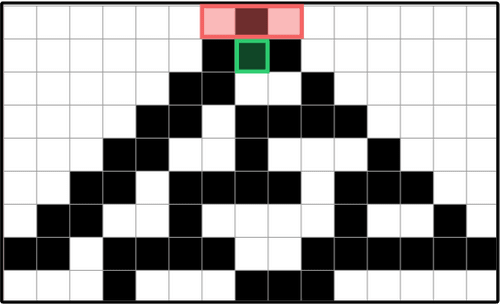
To determine whether the green cell is on or off, we check the three adjacent cells on the previous line (marked in red) and apply a simple rule.

This is the rule we'll apply. If the three red cells are (off, on, off), we'll turn the green cell on.
Now I'll show you how to apply the rule, line by line...
We'll begin with a grid. We can manually choose any starting condition, so I'll switch a single cell on to keep things simple...

Let's add another line, then apply the rule to each cell, one by one. This is what Line 2 looks like once it's completed...

Here's a neat little gif demonstrating the process. The computer uses the cells in Line 1 to determine the state of the cells in Line 2.
Cormullion, CC BY-SA 4.0, via Wikimedia Commons
After repeating the process for Line 3, we end up with this...

And on and on it goes. Here's what the first 16 lines look like...

And here's what the first 250 lines look like...
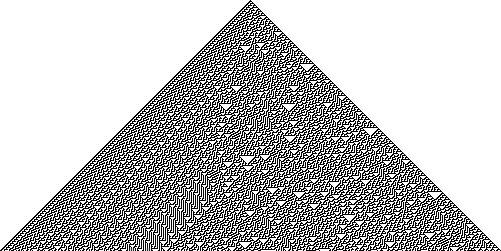
This is the full effect when the rule is applied line-by-line...
Cellular automata are a type of simple program. They've been extensively studied by Stephen Wolfram — a prominent computer scientist, physicist, mathematician, and businessman. Wolfram published a 1000+ page book in 2002 titled A New Kind of Science. This paragraph sums up his thesis:
It is not uncommon in the history of science that new ways of thinking are what finally allow longstanding issues to be addressed. But I have been amazed by just how many issues central to the foundations of the existing sciences I have been able to address by using the idea of thinking in terms of simple programs. For more than a century, for example, there has been confusion about how thermodynamic behavior arises in physics. Yet from my discoveries about simple programs I have developed a quite straightforward explanation. And in biology, my discoveries provide for the first time an explicit way to understand just how it is that so many organisms exhibit such great complexity. Indeed, I even have increasing evidence that thinking in terms of simple programs will make it possible to construct a single truly fundamental theory of physics, from which space, time, quantum mechanics and all the other known features of our universe will emerge.
For context, Wolfram isn't a curious little "crackpot" like me with no formal education. He was a bit of a child prodigy: he wrote three books on particle physics by the age of fourteen and published peer-reviewed scientific papers on quantum field theory and particle physics as a teenager. He received a Ph.D. by twenty, joined the faculty at Caltech, and became the youngest recipient of the Macarthur Fellowship (the "genius grant") in the early eighties.

He is now the billionaire founder of Wolfram Research (the software company responsible for Wolfram Mathematica and Wolfram Alpha). That's actually why I find him so interesting: he has a rare combination of domain expertise and "fuck you" money. He can research any idea he wants, just for the intellectual thrill. And he doesn't have to protect his academic career or lick someone else's boots for grant funding. He is one of the few people who can slaughter the scientific establishment's sacred cows without being completely laughed out of the room before he even opens his mouth.
Paul Graham, the founder of Y Combinator — the top startup accelerator in the world — elegantly articulates my point in his essay, Crazy New Ideas...
There's one kind of opinion I'd be very afraid to express publicly. If someone I knew to be both a domain expert and a reasonable person proposed an idea that sounded preposterous, I'd be very reluctant to say "That will never work."
Anyone who has studied the history of ideas, and especially the history of science, knows that's how big things start. Someone proposes an idea that sounds crazy, most people dismiss it, then it gradually takes over the world.
Most implausible-sounding ideas are in fact bad and could be safely dismissed. But not when they're proposed by reasonable domain experts. If the person proposing the idea is reasonable, then they know how implausible it sounds. And yet they're proposing it anyway. That suggests they know something you don't. And if they have deep domain expertise, that's probably the source of it.
Such ideas are not merely unsafe to dismiss, but disproportionately likely to be interesting. When the average person proposes an implausible-sounding idea, its implausibility is evidence of their incompetence. But when a reasonable domain expert does it, the situation is reversed. There's something like an efficient market here: on average the ideas that seem craziest will, if correct, have the biggest effect. So if you can eliminate the theory that the person proposing an implausible-sounding idea is incompetent, its implausibility switches from evidence that it's boring to evidence that it's exciting.
By now, you might've noticed the main similarity between cellular automata and Karl Friston's free energy principle: the same rule is applied to every entity.
In a cellular automaton, the same rule is applied to every cell. Each cell is defined by its border.

Every cell is an entity, defined by its border.
In the FEP, the same rule is applied to every "thing." Each "thing" is defined by its Markov blanket.

Every "thing" is an entity, defined by its Markov blanket.
Now here's where it gets fun...
Simple rules don't necessarily produce simple outcomes. They're capable of birthing incredible complexity and chaos.
To understand this concept, you'll need to understand emergence. To quote Wikipedia:
In philosophy, systems theory, science, and art, emergence occurs when an entity is observed to have properties its parts do not have on their own, properties or behaviors which emerge only when the parts interact in a wider whole.
Here's an example of emergence in art. Up close, this Monet painting looks like a random mishmash of individual brushstrokes. But if you zoom out and view the painting as a whole, an organized water-lily pattern emerges.

Claude Monet, CC BY-SA 2.5, via Wikimedia Commons
Here's an example of emergence in science...
At the Berkeley Radiation Laboratory, [David Bohm] began what was to become his landmark work on plasmas. A plasma is a gas containing a high density of electrons and positive ions, atoms that have a positive charge. To his amazement he found that once they were in a plasma, electrons stopped behaving like individuals and started behaving as if they were part of a larger and interconnected whole. Although their individual movements appeared random, vast numbers of electrons were able to produce effects that were surprisingly well-organized. Like some amoeboid creature, the plasma constantly regenerated itself and enclosed all impurities in a wall in the same way that a biological organism might encase a foreign substance in a cyst. So struck was Bohm by these organic qualities that he later remarked he'd frequently had the impression the electron sea was "alive."
In 1947 Bohm accepted an assistant professorship at Princeton University, an indication of how highly he was regarded, and there he extended his Berkeley research to the study of electrons in metals. Once again he found that the seemingly haphazard movements of individual electrons managed to produce highly organized overall effects. Like the plasmas he had studied at Berkeley, these were no longer situations involving two particles, each behaving as if it knew what the other was doing, but entire oceans of particles, each behaving as if it knew what untold trillions of others were doing. Bohm called such collective movements of electrons plasmons, and their discovery established his reputation as a physicist.
Now take a moment to examine this cellular automaton...
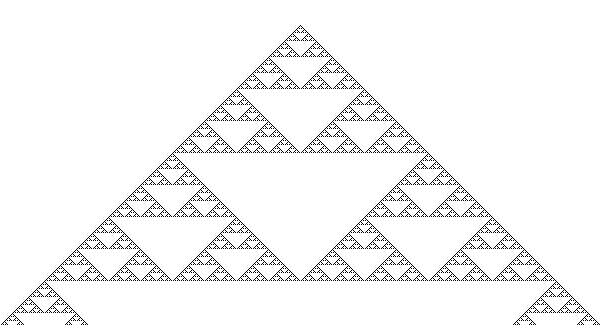
Stephen Wolfram refers to this CA as Rule 90.
Answer this question: Can you write a set of instructions (an algorithm) explaining how to draw this pattern?
Of course, the answer is "yes." You'd say, "Draw an upside-down triangle inside every right-side-up triangle." Simple, right?
Individually, each cell is either on or off. But if you zoom out and observe the information as a whole, a Sierpiński triangle emerges.
Like CAs, computer games consist of discrete units of information (pixels). Individually, the pixels have no meaning. But if you zoom out and view the pixels as a whole, you become engrossed in an emergent 3D illusion.
In this computer game, space and time are emergent illusions. Individual pixels are just colored squares. But if you zoom out and view the pattern as a whole, you can clearly see a man walking into a room full of soldiers.
That CA, known as Rule 90, is a highly-ordered pattern. I can easily predict what the next 1,000 steps will be and compress that information into an algorithm ("Draw an upside-down triangle inside every right-side-up triangle").

Rule 90 produces an ordered, predictable emergent pattern.
Similarly, when I kick a soccer ball, I can predict what the next 1,000 steps will be — how high, how fast, how far the ball will go. I can predict the pattern of information that will unfold.

Photo by Sven Kucinic.
Let's draw the connection here...
You observed order in Rule 90 and wrote an algorithm to describe that emergent pattern.
Similarly, Isaac Newton observed order in the universe and wrote algorithms (such as F = ma) to describe those emergent patterns. We can use Newton's algorithms to predict how a soccer ball will move through space and time.
Here's my point: science is the study and explanation of order in the universe. If the universe didn't contain ordered, predictable patterns, we could not perform science.
Hence, order is a key feature of our universe. It definitely exists. We know this with 100% certainty.
Let's read this paragraph from The Holographic Universe:
Classical science generally divides things into two categories: those that possess order in the arrangement of their parts and those whose parts are disordered, or random, in arrangement. Snowflakes, computers, and living things are all ordered. The pattern a handful of spilled coffee beans makes on the floor, the debris left by an explosion, and a series of numbers generated by a roulette wheel are all disordered.
As Bohm delved more deeply into the matter he realized there were also different degrees of order. Some things were much more ordered than other things, and this implied that there was, perhaps, no end to the hierarchies of order that existed in the universe. From this it occurred to Bohm that maybe things that we perceive as disordered aren't disordered at all. Perhaps their order is of such an "indefinitely high degree" that they only appear to us as random (interestingly, mathematicians are unable to prove randomness, and although some sequences of numbers are categorized as random, these are only educated guesses).
Now let's examine this cellular automaton, known as Rule 30...

Wolfram's Rule 30
Can you write a set of instructions (an algorithm) explaining how to draw this pattern?
If you look closely, you'll notice that the left-hand side is ordered and predictable. You could write an algorithm to predict portions of the left-hand side.

These are the first 50 steps of Rule 30. The highlighted section on the left-hand side is fairly ordered.
But as you move towards the right-hand side, the order turns into messy chaos. You'd throw your hands up in the air and say, "I can't write an algorithm to describe this pattern. It's random noise!"
Of course, I'm using Rule 30 as a metaphor for our universe. When scientists study the cosmos, they're actually studying an emergent pattern of information — just like Rule 30. Then they're writing separate, static algorithms to describe those pockets of order — whether they be chemical bonds, Newtonian physics, or microeconomics.
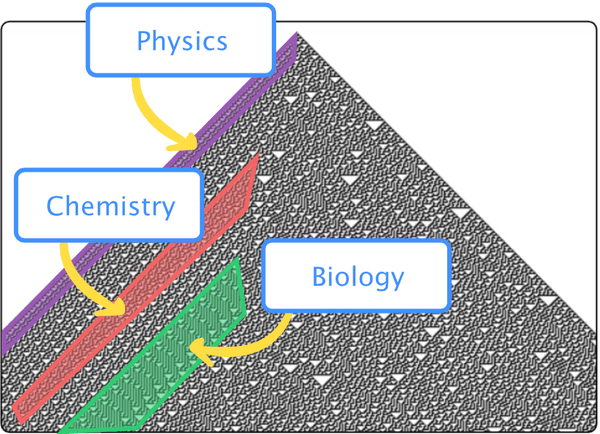
Chemists, biologists & physicists study pockets of predictable order in the overall emergent pattern.
But scientists can't write an algorithm to describe why your neighbour won the lottery, or why your child died of cancer, or why you randomly decided to go to that particular bar on that particular evening and say hello to that particular person who ended up being the love of your life. So we just call these events "random" — lucky or unlucky; chance; coincidence.
Hence, our current scientific paradigm separates patterns into two distinct categories: ordered and disordered.

This is Rule 30 divided into two distinct categories: ordered patterns and disordered patterns.
Yet, there's nothing random about that pattern. It was produced by a simple computation.

This is the simple rule that produced the emergent pattern.
At this point, we've established two things:
The observer 👁️ and the observed 🏠 are the same thing. Therefore, the extra dimensions of space and time must be emergent — just like they are in a computer game.Now let's construct a boolean function:
Are ordered and disordered patterns the same thing? True or false?
By that I mean, are random patterns actually ordered patterns, and we only call them "random" because humans haven't compressed the pattern into an algorithm yet?
Or, to phrase it differently, if you were an omnipotent, all-knowing God who wasn't limited by human perception, would the universe be 100% order and 0% disorder? Could you perfectly predict everything, including the "random" arrangement of spilled coffee beans and the chance meeting of two lovers? Do us ape-like humans only label things "random" because we can't see the underlying mathematical order in them yet?
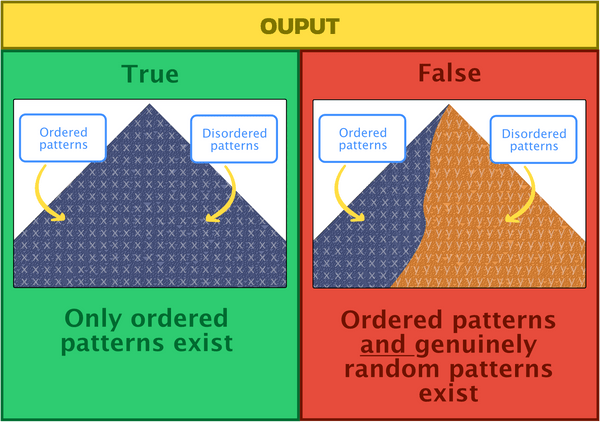
You know with 100% certainty that order (x) exists. Disorder could also be order, or it could be a separate, superfluous category of pattern (y) — a category that you have no evidence for. Hence, if you believe that circumstances and events in our universe are random, then you do it on blind faith. And blind faith is not science — it's religion.
Yet again, my weapon of choice — Occam's Razor — can slaughter the current scientific paradigm without anyone having to lift a finger. This swift and efficient assassination — alongside my 3-Step proof — can save the scientific community decades of endless debate as we transition to a new understanding of the world.

Occam's razor is a simple problem-solving heuristic: when presented with competing explanations, one should select the solution with the fewest assumptions.
As you can see, our scientific establishment has been handing out axioms like Oprah hands out free shit: "You get an axiom! You get an axiom! Everyone gets an axiom!"
They've then spent centuries passing down these false axioms in textbooks, as if those textbooks were bibles.
That's why I find it so ironic when militant materialists & atheists within the scientific community look down their noses at religious and spiritual people, yet these "rationalists" have blind faith in their own limited, anthropomorphic model of reality.
Take the famous Richard Dawkins, for example...
In a universe of electrons and selfish genes, blind physical forces and genetic replication, some people are going to get hurt, other people are going to get lucky, and you won't find any rhyme or reason in it, nor any justice. The universe that we observe has precisely the properties we should expect if there is, at bottom, no design, no purpose, no evil, no good, nothing but pitiless indifference.
Firstly, his statement is unfalsifiable. Tell me, Dawkins... what properties should we expect in a universe with "no design, no purpose, no evil, no good, nothing but pitiless indifference"? And conversely, what would you have to observe to say, "Ah, yes. The universe does have design/purpose/good/evil, so I was wrong"? Are you going to list a set of properties? Why were those properties chosen, in particular? And who are you to decide what "good" and "evil" look like? Are you a God — a moral arbitrator, laying down your arbitrary morals? Are you telling nature how to behave according to your chosen morality and then labeling it "naughty" or "nice," all the while pretending that you're nothing like the Christians with their ten commandments? Oh, I see. There's no logic underpinning any of this. It's just your personal opinion, and you're delivering a pessimistic sermon to the masses. Forgive me Father, for I have sinned: I worship at the altar of critical thinking.
To be clear: if you'd like to scientifically claim that the universe has "no rhyme or reason," you'll need to ask yourself two questions...
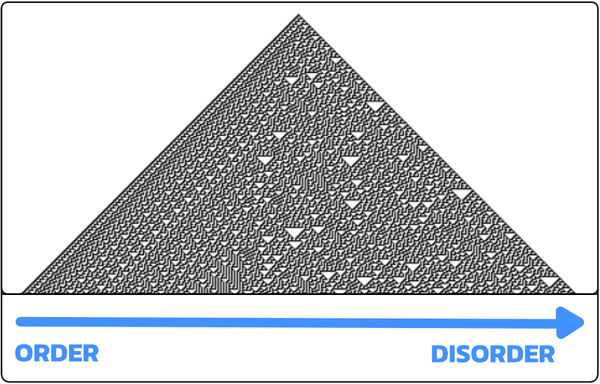
y? You're the one making a claim, so the burden of proof is on you.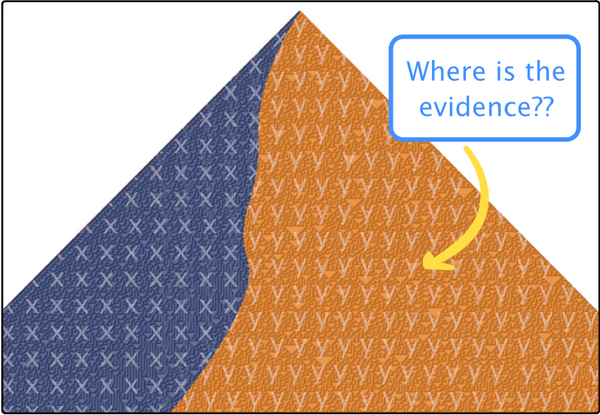
Don't get me wrong — I genuinely appreciate Dawkins, and I understand his gripe with organized religion (I consider myself a spiritual anarchist; this work is my manifesto). Yet Nietzsche's warning is poignantly relevant here — not only to Dawkins, but to anyone (myself included) on the search for truth: "He who fights with monsters might take care lest he thereby become a monster. And if you gaze for long into an abyss, the abyss gazes also into you."
Unfortunately, people like Dawkins have come to personify the kind of bloated, sloppy, dogmatic thinking that has led scientists astray over the past half-century: if a clever intellectual like him can't find the order in a pattern as intricate as our cosmos, then it must be a universe devoid of any "rhyme or reason" and full of "pitiless indifference."
I mean, come on, Dawkins. If you're going to arbitrarily appoint your own axioms and construct a faith-based religion on top of them, you could at least make it an exciting piece of fiction. Give humanity some hope, some inspiration, a sense that the human spirit can overcome all odds. Construct a myth, a hero, a legend: someone or something to believe in when they struggle to believe in themselves. Because your nihilistic model of reality is not only wrong — it's boring.
Let me offer you the wondrous, empowering, epistemologically-sound truth instead: there is deeply hidden order embedded in the chaos of our lives. Assuming otherwise is logically equivalent to believing in a flying spaghetti monster.
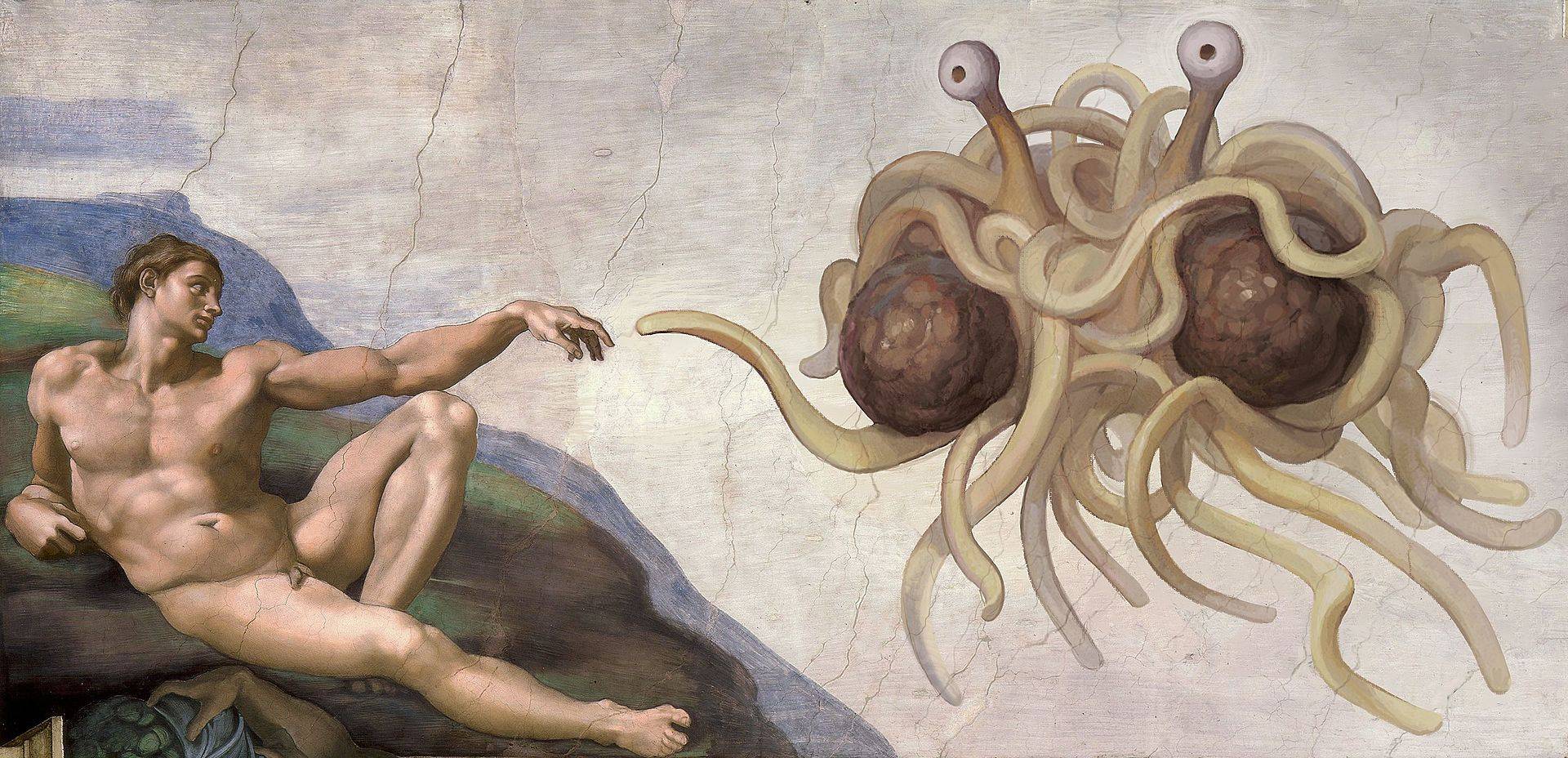
Now that you have the required background knowledge, I'll show you how to reverse-engineer the universe, step-by-step.
This is a key feature of Gameism: anyone can derive the philosophy from scratch using simple logic. It requires no blind faith. There is no central authority telling you what to believe. There's just an algorithm and its mathematical consequences.
Now, let's begin...
You are reading these words right now, so you know with 100% certainty that your consciousness exists. Let's call you the observer 👁️.
You can also observe a 3D world outside of yourself. Let's call this 3D world the observed 🏠.
You also know that meaning is produced when the observer 👁️ processes the observed 🏠. This "meaning" is your internal model of reality.
Let's add these three components to the system...
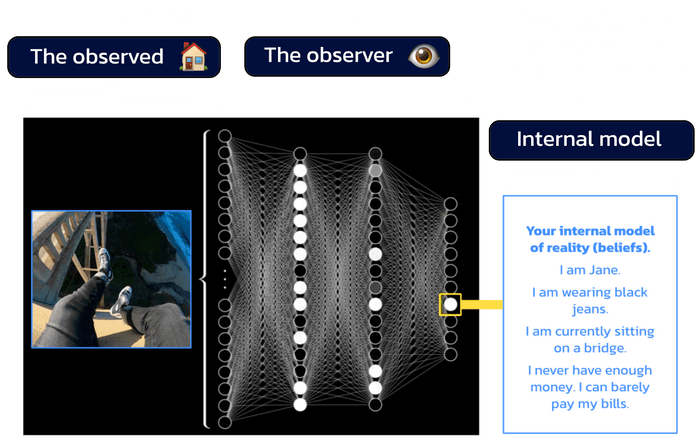
You observe your external reality, process that information, and form an internal model of reality (i.e. a belief system).
Now we'll construct the first function:
Are the observer 👁️ and the observed 🏠 the same thing? True or false?
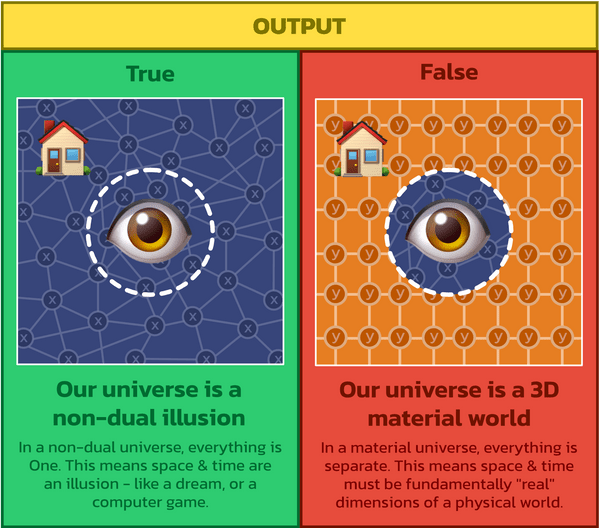
You know with 100% certainty that your consciousness (x) exists. The world outside of you could also be x, or it could be a separate, superfluous entity (y) — an entity that you have no evidence for. Hence, if you believe in y, you do it on blind faith. And blind faith is not science — it's religion.
The answer is true. Therefore, the dimensions of space and time must be emerging from a lower dimension where everything is One.
We'll add this lower dimension to our model...
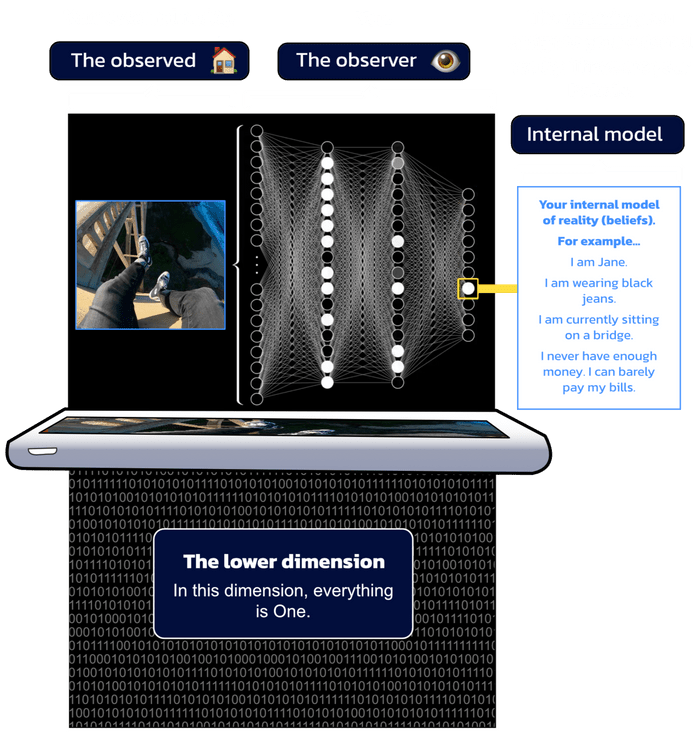
Now we'll construct the second function:
As an the observer 👁️, are you a conscious system? True or false?

If x is a conscious system, then the universe is a conscious system observing itself.
The answer is true.
If the lower dimension is a conscious system, then we know it also has three components: the observer 👁️, the observed 🏠, and meaning / output.
And if the universe is a conscious system observing itself, then we can link the components together like this...
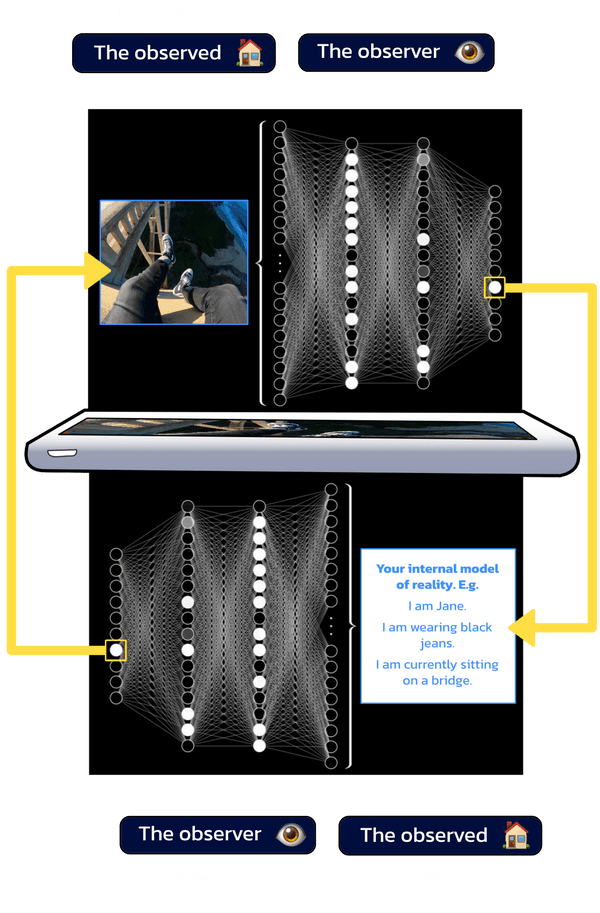
The meaning / output of one layer becomes the observed 🏠 in the other layer.
If you look closely, you'll notice the universe has the same architecture as a computer game. This architecture is called a "game loop".

The player observes an emergent pattern of information in the game world. They respond with input (in this case, it's their internal model of reality). The gaming engine calculates the next emergent pattern to unfold and renders that information on the player's external world.
Now we just have one more thing to figure out: what's happening in the gaming engine? What are the mathematical rules of the game?
Well, we can reverse-engineer that too...
Let's assume we're searching for an algorithm that's generating everything we observe in our external reality.
What features might we expect it to have?
Well, we've just proved that the universe consists of ordered and disordered patterns, yet the disordered patterns have a deeply hidden order to them. So we're looking for an algorithm capable of generating predictable order and "random" complexity and chaos.
Humans also have a strong intuition that the laws of nature are simple and elegant. Scientists drool over efficient compression algorithms (like Einstein's theory of relativity), and for a good reason (I'll explain why in Chapter Five: The Theory of Magic. It's got a lot to do with entropy). If one can predict everything in the universe using a simple mathematical statement, they've just discovered the Holy Grail — and I mean that literally: the algorithm is God.
Given all of this, we're looking for something that's:
Simple programs tick both of these boxes. Hence, we'll focus our search on algorithms that apply the same rule to every entity.
Yet, what is an entity? Isn't it something in particular: for example, a particular cell on a 2D grid?

In a CA, "particular" cells are defined by their border.
Okay... well, the gaming engine isn't a grid. It's a neural network. So how do we define particular things in a neural network?
Why, Markov blankets, of course! Every entity is defined by its Markov blanket.

A Markov blanket is a mathematical boundary separating something from what it is not.
Great. So now we're looking for a simple rule applied to every Markov-blanketed entity within a neural network.
Yet, if our universe is a neural network, then we know it contains Markov blankets within Markov blankets within Markov blankets. When you draw the system, you end up with something like this...

Every Markov blanket is represented by a Sierpiński triangle.
So now we're looking for a recursive computation where the same rule is applied within every Markov blanket.
But how do we figure out what the specific rule is?
Simple. We observe conscious systems in nature and identify their fundamental behavior.
We can start by answering this question: What is the key difference between a living fish and a dead fish?
Answer: The living fish is constantly adjusting itself to resist entropy.

If a fish doesn't adjust itself to resist entropy, it will make the ultimate venture into chaos: death.
Great. That'll do. We'll assume every Markov-blanketed "thing" is constantly adjusting itself to resist entropy.
In other words, every entity is minimizing its surprise, thereby maximizing evidence for its own self-existence. Every "thing" is getting a physical experience of its own consciousness.
Which makes sense, right? Because we'd also expect the computation to be philosophically satisfying; to have some kind of spiritual message embedded in the math. There's a human intuition that we're more than just mechanical meat-robots lumbering around Earth; that we were born with a purpose beyond survival and replication: eat, sleep, fuck, die. Maybe we're here to experience love, or joy, or something?
Think about it... once our basic needs are met, why do we feel that internal pull to self-actualize; to take a crazy risk and chase our dreams; to charge straight into the chaotic unknown and see what life is really all about?
If conscious systems only resisted chaos in the present moment, they'd never step into the unknown. And without stepping into the unknown, it would be mathematically impossible to change and evolve. The words you are reading right now would never have manifested in the game because formulating this thesis required getting out of my safe, predictable comfort zone. I ventured into chaos, not away from it.
So, what if the computation is closing the gap between my current, limited model of reality ("I am Nikki Durkin. I am separate to everything outside of me. I can't do that, or that, or that") and a perfect model of reality ("I am everything; I am God; There are no limits to what I can create"). In other words, what if it's also minimizing the free energy in the future, from now until the end of "time"? That would explain the mathematical pull towards self-actualization and enlightenment.
And there you have it: all roads lead back to Karl Friston and his free energy principle. This is the needle in a haystack that we're searching for...
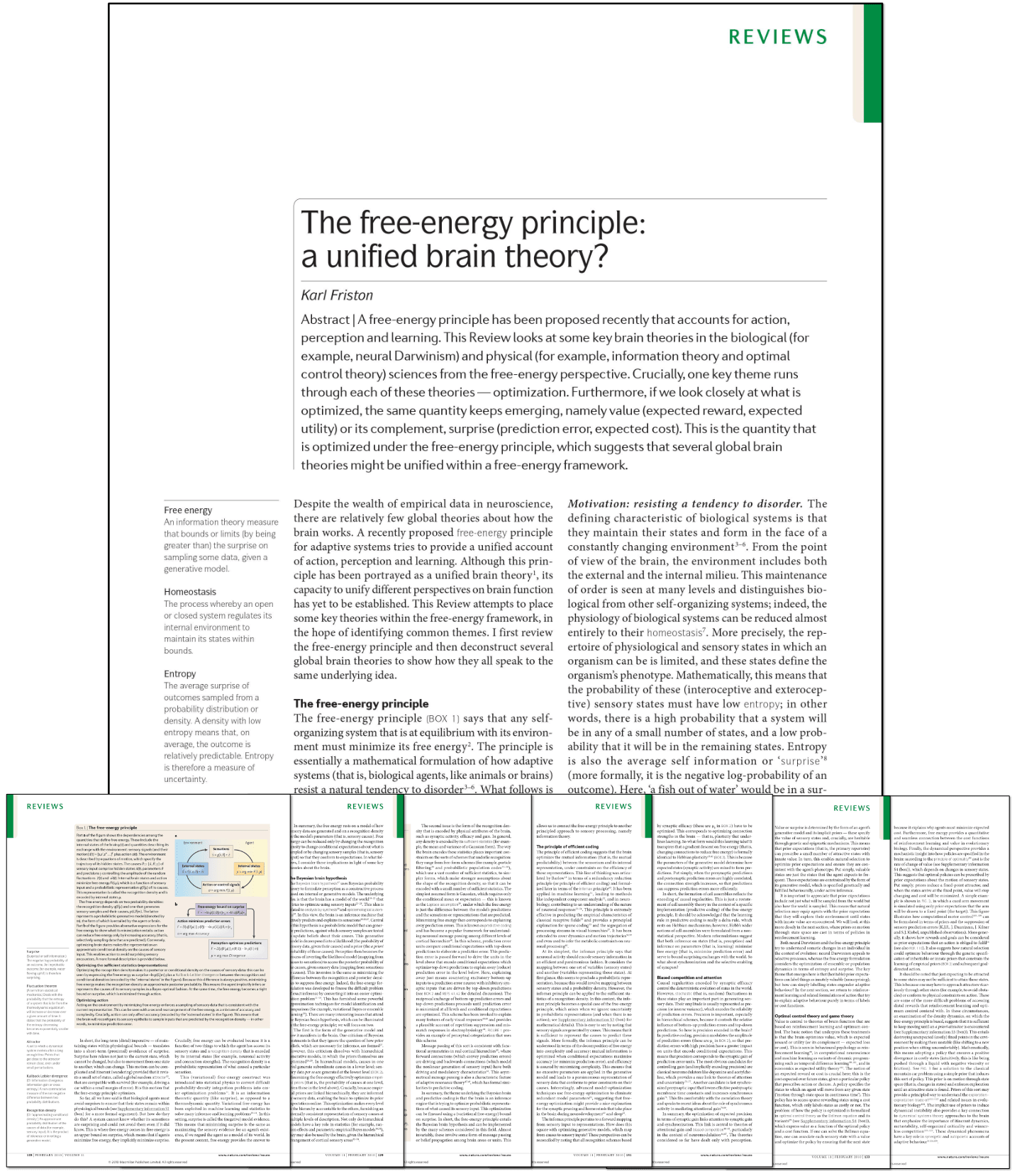
An article by Karl Friston in Nature Reviews Neuroscience, published February 2010.
Incidentally, I wrote down all of this logic in 2019 while I was sitting in my bedroom. In fact, I wrote well over 100,000 words in a two-week period — words that, years later, would form the basis of this book.
I also placed my bet on this intellectual treasure hunt: Stephen Wolfram was going to connect the dots, and so was Friston. "Just watch," I told my parents in 2019. "They're getting closer. It's only a matter of time until they figure it all out."
Then in April 2020 — right at the beginning of a surprising pandemic and a solid eighteen years after publishing A New Kind Of Science — Stephen Wolfram announced his Wolfram Physics Project: a search for the fundamental theory of physics focused on simple programs operating on a structureless "hypergraph"...
It’s unexpected, surprising—and for me incredibly exciting. To be fair, at some level I’ve been working towards this for nearly 50 years. But it’s just in the last few months that it’s finally come together. And it’s much more wonderful, and beautiful, than I’d ever imagined.
In many ways it’s the ultimate question in natural science: How does our universe work? Is there a fundamental theory? An incredible amount has been figured out about physics over the past few hundred years. But even with everything that’s been done—and it’s very impressive—we still, after all this time, don’t have a truly fundamental theory of physics.
Back when I used do theoretical physics for a living, I must admit I didn’t think much about trying to find a fundamental theory; I was more concerned about what we could figure out based on the theories we had. And somehow I think I imagined that if there was a fundamental theory, it would inevitably be very complicated.
But in the early 1980s, when I started studying the computational universe of simple programs I made what was for me a very surprising and important discovery: that even when the underlying rules for a system are extremely simple, the behavior of the system as a whole can be essentially arbitrarily rich and complex.
And this got me thinking: Could the universe work this way? Could it in fact be that underneath all of this richness and complexity we see in physics there are just simple rules? I soon realized that if that was going to be the case, we’d in effect have to go underneath space and time and basically everything we know. Our rules would have to operate at some lower level, and all of physics would just have to emerge.
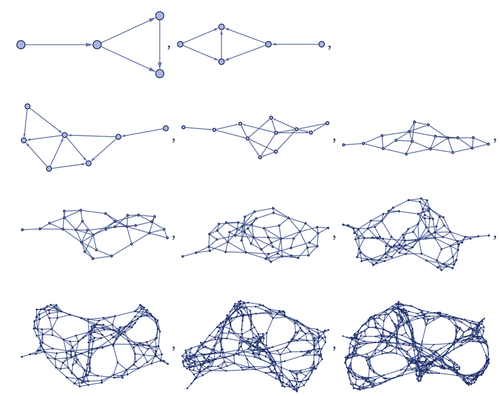
Instead of applying simple rules to 2D grids (like in cellular automata), Wolfram Physics Project applies simple rules to a collection of abstract elements with abstract relations (a kind of graph structure). This image is the result of one such rule.
I was living in Colombia when Wolfram announced the project. I called my parents and said, "See. I told you this would happen. If you think I'm wasting my time with this work, then so is Wolfram. Now watch: Friston is going to begin talking about the FEP as a theory of everything."
Another year went by. During that time, I wrote hundreds of thousands of words on this topic. Once my core thesis was complete, a podcast episode dropped. In it, Friston talked about the FEP as a potential "theory of every 'thing'" (with "things" being defined by their Markov blanket).
I have an unusual cognitive strategy: I don't like polluting my mind with other people's conclusions until I've independently formed my own. I enjoy engineering logical structures, line by line, from scratch — like writing epistemic code in my mind. Once the code is written, I mentally run the program and compare the output to other people's conclusions.
Given this, I never bothered to deeply research the FEP after I came across it in February 2019. It was a simple and intuitive rule at a high level, and I didn't want to get bogged down in the details. I just ran the computation in my mind to derive the intellectual foundations of Gameism. Then I built myself a system called Atlas, which I used on a daily basis to integrate this philosophy into my life.
So I didn't notice when, four months later (in June 2019), Friston released a paper about the FEP's application in physics. The paper didn't come to my attention until 2021 — after I'd independently built Gameism on top of his brilliant work.
Abstract
This monograph attempts a theory of every ‘thing’ that can be distinguished from other ‘things’ in a statistical sense. The ensuing statistical independencies, mediated by Markov blankets, speak to a recursive composition of ensembles (of things) at increasingly higher spatiotemporal scales. This decomposition provides a description of small things; e.g., quantum mechanics – via the Schrödinger equation, ensembles of small things – via statistical mechanics and related fluctuation theorems, through to big things – via classical mechanics. These descriptions are complemented with a Bayesian mechanics for autonomous or active things. Although this work provides a formulation of every ‘thing’, its main contribution is to examine the implications of Markov blankets for selforganisation to nonequilibrium steady-state. In brief, we recover an information geometry and accompanying free energy principle that allows one to interpret the internal states of something as representing or making inferences about its external states. The ensuing Bayesian mechanics is compatible with quantum, statistical and classical mechanics and may offer a formal description of lifelike particles.
Friston — arguably the top neuroscientist in the world — had come to the same conclusion as a curious little hacker, sitting in her bedroom: the free energy principle goes way beyond neuroscience.
When the podcast dropped in 2021, I called my parents again. "That was the second domino," I said. "First Wolfram, now Friston. And it's all converging in the background of a sudden pandemic, which must be minimizing free energy in the future — otherwise, the game wouldn't have manifested such a large collective prediction error. The system's about to undergo a revolution. It's like watching the tide pull out before the tsunami hits..."



A tanned, shirtless guy with sandy feet rode by on his bicycle, narrowly missing a coconut on the sidewalk. An enthusiastic labrador ran after him. Palm trees, coconuts, bicycles, sand — it was April 2021, just another day in Mexico. I was taking a short stroll around my favorite neighborhood.
The guy circled back and stopped his bike. I can’t remember exactly what he said to me, but I do remember it being one of the cheesiest pickup lines I’d ever heard. So cheesy, in fact, that I burst out laughing.
Gameism is an indie project by Nikki Durkin

